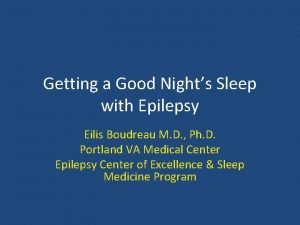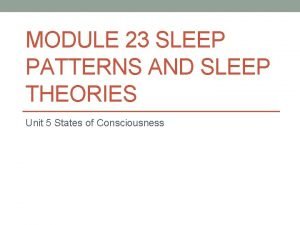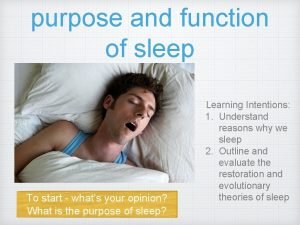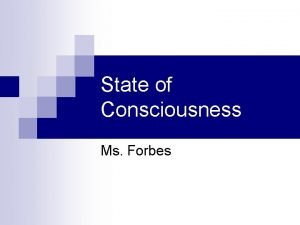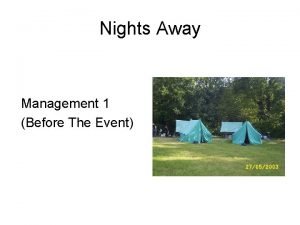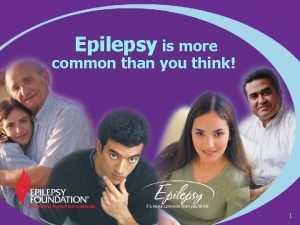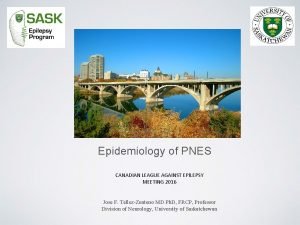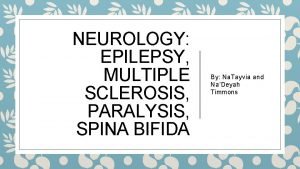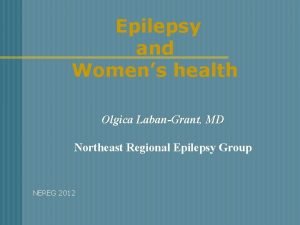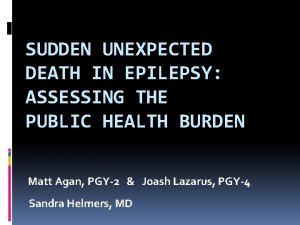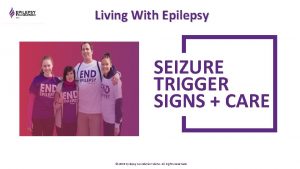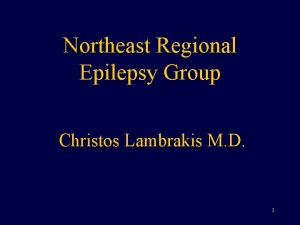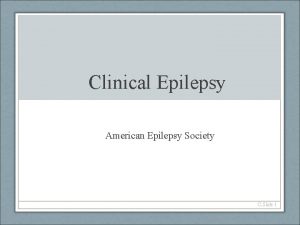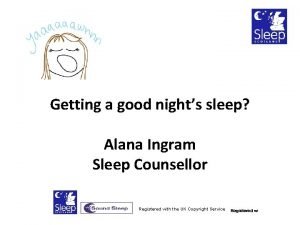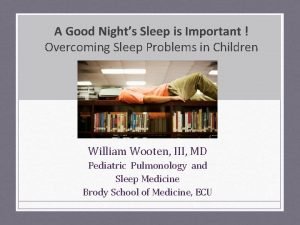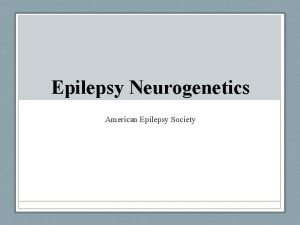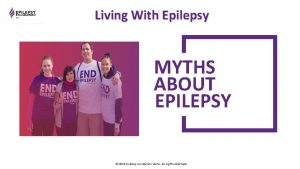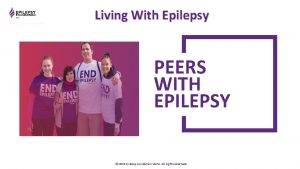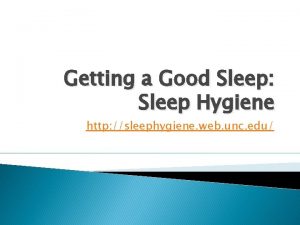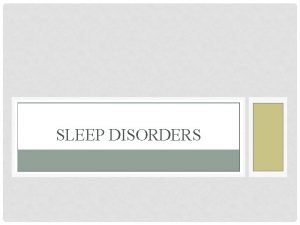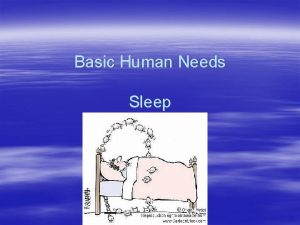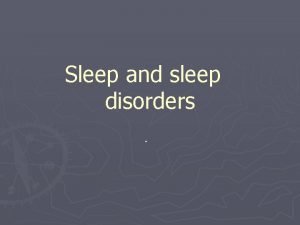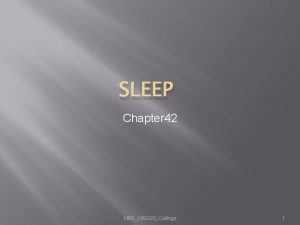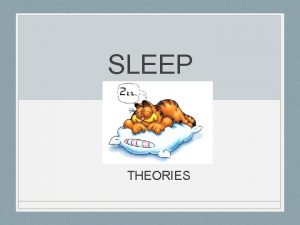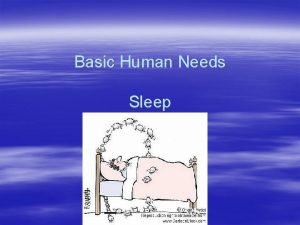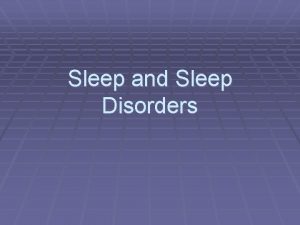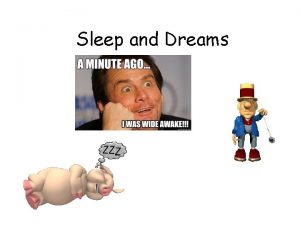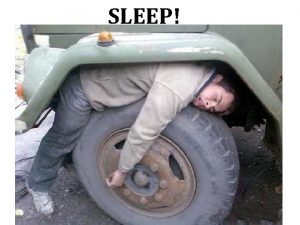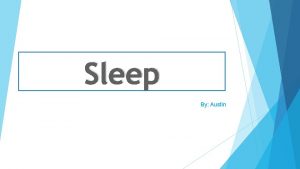Getting a Good Nights Sleep with Epilepsy Eilis

































- Slides: 33

Getting a Good Night’s Sleep with Epilepsy Eilis Boudreau M. D. , Ph. D. Portland VA Medical Center Epilepsy Center of Excellence & Sleep Medicine Program


Outline • • • What is the function of sleep? How much sleep do we need? Sleep Basics Common sleep disorders Best Sleep Practices

Why do we sleep?

Sleep Requirements • Average adult: 7. 5 -8 hours • Epidemiology: sleep>9 hours or <4 hours have higher chance of death secondary to CAD, stroke and cancer vs 7 -8 hour/night sleepers • During pre-light bulb Victorian era, average sleep times closer to 10 hrs/day

HOW MUCH SLEEP DO WE GET?

Epidemiology: 2006 CDC Report 35. 0% 30. 0% 29. 6% 32. 6% 0 Days 25. 0% 1 -6 Days 20. 0% 15. 0% 10. 0% 5. 0% 0. 0% 7 -13 Days 12. 9% 12. 2% 10. 1% 2. 6% 14 -20 Days 21 -29 Days 30 Days # Days of insufficient sleep http: //www. cdc. gov/mmwr/preview/mmwrhtml/mm 5708 a 2. htm

SLEEP BASICS

Sleep Basics • Drive to sleep driven by: – Internal body clock (circadian) – How much sleep debt we’ve built up

Regulation of Sleep From “Update on the Science, Diagnosis and Management of Insomnia”, ed Gary Richardson, 2006, pg. 13.

Nighttime Sleep Cycles • Each cycle last approximately 90 -110 minutes • 4 -6 cycles per night • During first cycles Rapid Eye Movement (REM) component only a few minutes • First 2 cycles have significant slow wave sleep • Later cycles dominated by REM

COMMON SLEEP DISORDERS

Most Common Sleep Disorders • Restless Leg Syndrome • Sleep-disordered breathing • Insomnia

Restless Leg Syndrome • Clinical diagnosis - Urge to move legs - Begins or worsens during rest - Relieved with movement - Worst or only occurs at night

RLS: Epidemiology • Two peaks of incidence - 2 nd decade - 4 th and 5 th decades

RLS Treatment • Dopamine agonists (ex. ropinirole) • Other treatments include gabapentin, clonazepam, narcotic meds for very resistant cases • Non-pharmacological: decrease caffeine, nicotine, alcohol; massage legs; warm baths before bedtime

Sleep Disordered Breathing • Episodes of difficulty breathing or cessation of breathing for at least 10 seconds

Sleep Disordered Breathing • Snoring (but many people snore and DON’T have apnea) • Witnessed apneas • Excessive daytime sleepiness • AM headaches • Dry mouth

Factors that Increase Risk for Sleep. Disordered Breathing? • • • Being overweight Larger neck circumference Being a male Increased age Post-menopausal

Obstructive Sleep Apnea: Epidemiology • 5% - 20% adults • Males > Females

Why treat Sleep-Disordered Breathing? • Short-term: patients feel better and function better • Long-term: prevent long-term complications of apnea

Sleep Apnea and Epilepsy • Treatment of sleep apnea may improve seizure control

Diagnosis and Treatment of Sleep Apnea • Diagnosis: Overnight sleep study in the sleep laboratory • Treatment: CPAP

Insomnia • Multiple causes. • Is a symptom, many times of multiple issues. • Need to evaluate underlying problems to get at root cause.

Insomnia and Epilepsy • Increased awakenings in patients with epilepsy – ? seizures – ? medication side-effects (lamotrigene, felbamate, levetiracetam)

BEST SLEEP PRACTICES

Best Sleep Practices • • • Set-up bedroom only for sleep. Have a regular sleep routine. Keep a regular bedtime and wake time. Protect your sleep time from other activities. Avoid alcohol before bedtime. Limit caffeinated beverages.

Sleep in Epilepsy • Seizures at night common with some types of epilepsy. • Seizures can disrupt normal sleep. • Sleep-deprivation may trigger seizures. • Depression and anxiety more common in epilepsy and also disrupt sleep.

Sleep, Epilepsy, and Alcohol • Alcohol may increase chance of seizure (especially binge drinking) • Alcohol significantly disrupts sleep • Significant alcohol intake not good for seizure control or sleep

Summary of What We Know About Sleep and Epilepsy • Poorer sleep quality • Apnea may be more common and treatment may improve seizure control • Antiepileptic medications may worsen sleep (fragment sleep, increase insomnia)

BEST SLEEP PRACTICES

Best Sleep Practices • • • Set-up bedroom only for sleep. Have a regular sleep routine. Keep a regular bedtime and wake time. Protect your sleep time from other activities. Avoid alcohol before bedtime. Limit caffeinated beverages.

Improving Sleep in Epilepsy • Optimize epilepsy treatment • Discuss any medication side-effects with care provider • Practice good sleep hygiene • Identify and treat sleep disorders such as apnea • Tell you care provider if you develop sleep problems
 Eilis boudreau
Eilis boudreau The secret of getting ahead is getting started
The secret of getting ahead is getting started Module 16 sleep patterns and sleep theories
Module 16 sleep patterns and sleep theories Module 23 sleep patterns and sleep theories
Module 23 sleep patterns and sleep theories Come sleep o sleep summary
Come sleep o sleep summary Module 23 sleep patterns and sleep theories
Module 23 sleep patterns and sleep theories Adults spend about ______% of their sleep in rem sleep.
Adults spend about ______% of their sleep in rem sleep. Good thoughts good deeds good words
Good thoughts good deeds good words Hello good afternoon teacher
Hello good afternoon teacher Good afternoon tom
Good afternoon tom Cómo se dice buenas tardes
Cómo se dice buenas tardes You are good you are good when theres nothing good in me
You are good you are good when theres nothing good in me A midsummer night's dream motifs
A midsummer night's dream motifs Vincent van gogh starry night song
Vincent van gogh starry night song I fled him
I fled him Midsummer nights adrian
Midsummer nights adrian Hatchet moose attack
Hatchet moose attack Neverwinter nights 2 editor
Neverwinter nights 2 editor Black saturday
Black saturday Dua for the last ten nights of ramadan
Dua for the last ten nights of ramadan So many nights i sit by my window
So many nights i sit by my window Tis all a checkerboard of nights and days
Tis all a checkerboard of nights and days Talladega nights prayer
Talladega nights prayer Nights away permit checklist
Nights away permit checklist Difference between seizure and epilepsy
Difference between seizure and epilepsy Canadian league against epilepsy
Canadian league against epilepsy Spina bifida and epilepsy
Spina bifida and epilepsy Catamenial epilepsy and birth control pills
Catamenial epilepsy and birth control pills Epilepsy death
Epilepsy death Letazol
Letazol Seizure triggers
Seizure triggers Xl spikes on eeg
Xl spikes on eeg Epilepsy
Epilepsy Northeast regional epilepsy group
Northeast regional epilepsy group
